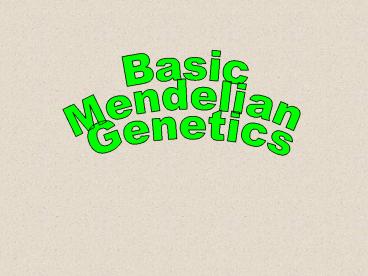Basic - PowerPoint PPT Presentation
1 / 40
Title:
Basic
Description:
Mendel experimented with peas from his garden using the following traits. Height: Tall Short. Mendel experimented with peas from his garden using the following traits ... – PowerPoint PPT presentation
Number of Views:55
Avg rating:3.0/5.0
Title: Basic
1
Basic Mendelian Genetics
2
Modern genetics is base on the
work of Gregor Mendel, during
the 1860s, in a Brünn,
Austria monastery.
Gregor Mendel
1823-1884
3
To discuss and understand Mendels work and
genetic principles it will be necessary to learn
a few definitions.
4
P generation
P parent
The first 2 individuals involved in a series of
crosses or in a family
5
F1 generation
F filial (Latin for children or
offspring)
F1 children or offspring of parent
generation F2 grandchildren or
offspring of two F1s
6
Genotype
The make up of the genes in a particular
individual
Phenotype
The outward appearance of an individual resulting
from its genotype
7
Allele
An alternate version of a gene
If we are considering length of tail, the 2
alleles might be long and short. There are always
2 alleles and sometimes more.
8
Gamete
A reproductive cell. Egg or sperm
Zygote
A cell resulting from the union of 1 egg and 1
sperm. A fertilized egg.
9
Dominant
An allele that covers its alternate. It always
shows.
Recessive
The allele that is covered. It only shows when it
is pure.
10
Homozygous
The 2 genes in a pair are the same. Pure. (TT)
Heterozygous
The 2 genes in a pair are different. Hybrid. (Tt)
11
Mendel experimented with peas from his garden
using the following traits
Height Tall Short
12
Mendel experimented with peas from his garden
using the following traits
Pod shape constricted inflated
13
Mendel experimented with peas from his garden
using the following traits
Pod color yellow green
14
Mendel experimented with peas from his garden
using the following traits
Seed color yellow green
15
Mendel experimented with peas from his garden
using the following traits
Seed shape Wrinkled Smooth
16
Mendel experimented with peas from his garden
using the following traits
Flower color White Pink
17
Mendel experimented with peas from his garden
using the following traits
Flower position Axial Terminal
18
Mendel developed true breeding (giving the same
result every time) strains of peas for each of
these alleles. Then began crossing them and
recording the results.
19
One of his trials went like this
Mendels P generation
X
Tall
Tall
20
One of his trials went like this
Every one of the offspring (F1) were tall. What
happened to the short gene, he wondered?
F1
Tall
21
Next he crossed 2 of his F1s
X
Tall F1
Tall F1
22
This resulted in an F2 generation with these
results
X
¾ Tall F2
¼ Short F2
23
Mendel duplicated his work using all 7 of the
traits he had identified and got the same result
with each one. This led him to the formation of 4
basic laws of genetics.
24
The allele that always appeared in the F1
generation, he called dominant.
The allele that disappeared in the F1 but
reappeared in the F2, he called recessive.
25
Mendel found the following
Dominant Yellow seed Green pod Inflated pod
Smooth seed Tall plant Axial
flower Pink flower
Recessive Green seed Yellow pod Constricted pod
Wrinkled seed Short plant
Terminal flower White flower
26
Through his research, experimentation, meticulous
records, and application of statistical
principles, Mendel proposed 4 laws of genetics
27
Law of unit character -
Each trait or character is controlled by a pair
of factors (genes) one from each parent.
28
Law of segregation -
During the formation of gametes, the pairs of
factors (genes) separate with only one from each
parent pair going to the gamete
29
Law of independent assortment -
During the formation of gametes, which allele for
each factor that goes to the gamete does not
depend upon any other allele of any other factor.
30
Law of dominance -
In a pair of factors, one of the pair will mask
(cover up) (dominate) the expression of the other
member of the pair (recessive).
31
In the early 1900s an English scientist and
mathematician, in an effort to visualize Mendels
concepts, developed a method to statistically
predict and/or analyze the result of various
crosses.
32
The device was called a Punnett square
named after its inventor -
Reginald C. Punnett
33
Using a Punnett square goes like this
1. Factors are represented by letters. Usually
the first letter of the dominant allele.
34
2. The dominant allele is represented by a
capital letter and the recessive by a lower case
letter.
3. Gametes are represented by 1 letter and
zygotes by 2.
35
If we cross a pure (homozygous) tall plant with a
pure short plant it would look something like
this
36
Tall dominant gene T Short recessive
gene t Homozygous tall TT Homozygous
short tt Heterozygus tall Tt
This is the key and goes at the beginning of
EVERY problem!
37
Pure tall X pure short
tt
TT
X
T
T
T
T
T
T
T
T
100 hybrid tall
t
t
t
t
t
t
t
t
t
t
38
Heterozygous tall F1 X Heterozygous Tall F1
Tt
Tt
X
¼ pure
tall ½ hybrid
tall ¼ pure short
T
t
T
t
T
T
t
t
T
T
T
T
T
T
t
t
t
t
39
Only Mendels Law of Unit Character has been
changed. We know now that some traits are
controlled by more than a single pair of genes.
40
We also know that some genes are Co-dominant and
some are incompletely dominant and some are sex
linked. But the basic concepts have remained for
almost 150 years.































